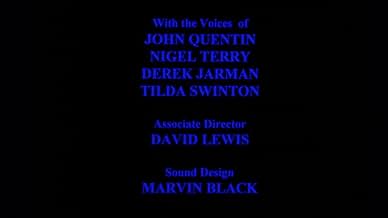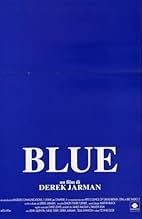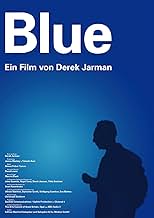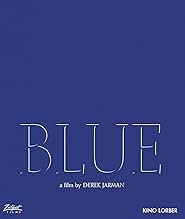Ajouter une intrigue dans votre langueIn his final - and most daring - cinematic statement, Jarman the romantic meets Jarman the iconoclast in a lush soundscape pulsing against a purely blue screen, laying bare his physical and ... Tout lireIn his final - and most daring - cinematic statement, Jarman the romantic meets Jarman the iconoclast in a lush soundscape pulsing against a purely blue screen, laying bare his physical and spiritual state.In his final - and most daring - cinematic statement, Jarman the romantic meets Jarman the iconoclast in a lush soundscape pulsing against a purely blue screen, laying bare his physical and spiritual state.
- Récompenses
- 2 victoires et 1 nomination au total
- Self
- (voix)
- …
- Narrator
- (voix)
- Narrator
- (voix)
- Narrator
- (voix)
Avis à la une
Jarman's story is one that does not need visuals to support it. Reflecting upon his life in the face of his rapidly approaching death, Jarman's memories and meditations offer the viewer (listener, really) a window into the soul of a director who is losing the most important sense he could posses: his sight. Blue was the last color available to him before AIDS related complications robbed him of his sight. As he stands before death and stares it straight in the face, Jarman's writings put forth a suprising feeling of calmness, as he has accepted his own finitude and shares his meditations with us in this, his last masterpiece.
feature in which his diaristic reminiscences, and commentary on
his current degeneration from AIDS symptoms, are set against a
placid musical score and a cool, empty blue background.
An obviously simple idea, but what an amazingly rich one: Jarman
has created the closest movie experience to a director talking to
the inside of your head. The concomitant feelings of control-losing
peace and terrifying hallucination (one obviously starts to project
images into the blue blankness) are...well, so obviously apt, aren't
they? For a film about spirit, and about the interiorness of
everyone's reactions, BLUE is remarkably controlled in its effects.
It provides an experience adult viewers haven't had much since
childhood--of letting go and getting lost.
But to dismiss it out of hand as no better than a first year art student's project is to fail to appreciate the rich narrative.
The coldness of the blue focusses the mind on what Jarman has to tell us, perhaps far better than any other colour would've done. We cannot help but listen, and take in one very gifted man's grim yet positive perspective on gay life, and a slow death through AIDS.
Brian Eno's musical score is stark and haunting, with passages of female vocal harmony that are strongly influenced by contempory sacred music from Eastern Europe.
Watch this film with an open mind: Force yourself to keep staring into the blue yonder, and it will empower you with a new level of vision and perspective.
Some will find the whole affair a pretentious bore. Others will find it a moving farewell from a groundbreaking British film-maker who was completely blind by the time the film was completed. He broke the rules, especially with this film, and it's probably how he wanted to be remembered.
Le saviez-vous
- AnecdotesDerek Jarman went completely blind as a side effect of AIDS which is why this film is audio based. He died the year after its production.
- Citations
Terry, Nigel: We've always been mistreated and the moment anyone gives us the slightest bit of attention we over-react with our thanks.
- ConnexionsFeatured in Derek Jarman: Life as Art (2004)
Meilleurs choix
- How long is Blue?Alimenté par Alexa
Détails
Box-office
- Budget
- 90 000 £GB (estimé)
- Durée
- 1h 19min(79 min)
- Mixage
- Rapport de forme
- 1.85 : 1
























